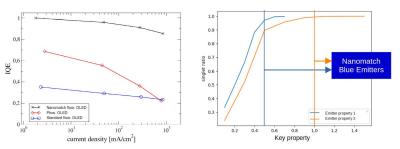This is a sponsored post by Nanomatch
Using their in-house virtual design tools, Nanomatch developed a new class of emitters that enables the production of stable, fluorescent OLED devices with close to 100% internal quantum efficiency also in the blue color range.
The specific class of fluorescent emitters facilitates the generation of only singlets with radiative decay of the order of 10-8s, thereby eliminating quenching processes induced by long-lived triplets. Having filed the patent end of February 2023, Nanomatch is now looking for partners to commercialize this new concept in order to realize efficient, stable blue OLEDs on an industrial level.
With close to 100% IQE, how does these materials compare to PHOLEDs, TADF, etc?
With close to 100% IQE we outperform TTF (triplet triplet fusion, theoretical maximum of 62%), which is, as far as we know, the current industrial standard for realizing stable blue OLED pixels. As far as we know, PHOLED and TADF do not reach sufficient lifetimes in the blue color range.
Any notes on lifetime and color point for RGB?
We do not have experimental evidence of the lifetime yet, however we expect a long lifetime due to (i) only singlets with fast radiative decay, i.e. no long-lived triplets in the system that can induce quenching and (ii) reduced quenching by molecular design. Color point can be tuned to a certain extend with this class of molecules, so we hope to meet the requirements from industry.
How close are these materials to commercialization?
We are still in the prototyping stage. While this means that proper commercialization is a long way to go, it also means that we can align development strategies with potential end-users from an early stage.
Can you expand on the material science behind the new emitters?
The only technical explanation we can disclose at this stage is that we suppress the formation of triplets by orders of magnitude, resulting in only singlets with fast radiative decay, thereby reducing probability of harmful quenching events (resulting in the destruction of chemicals) by orders of magnitude.
Interested potential end-users, experimental partners or people seeking investment opportunities can get in touch with Nanomatch via email.
